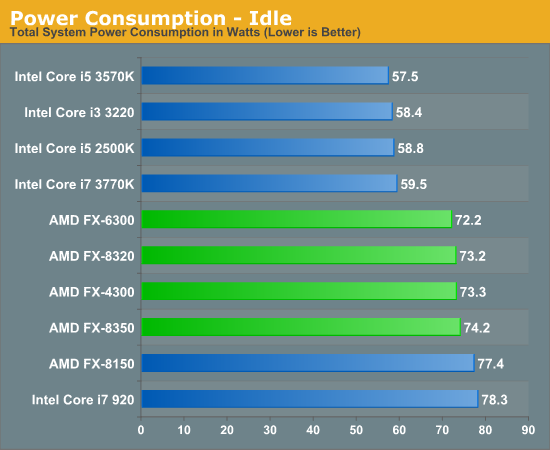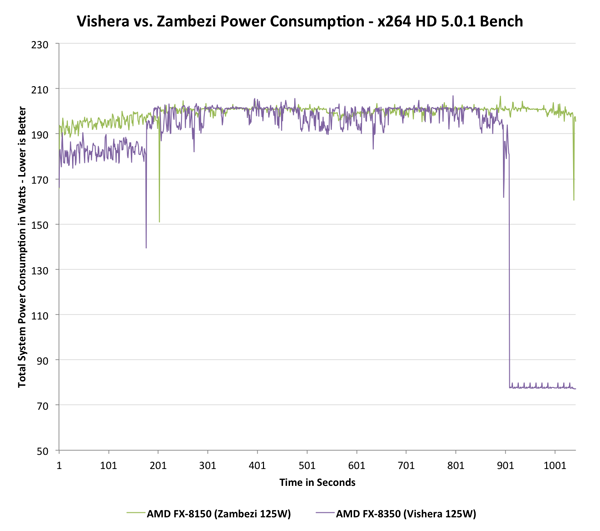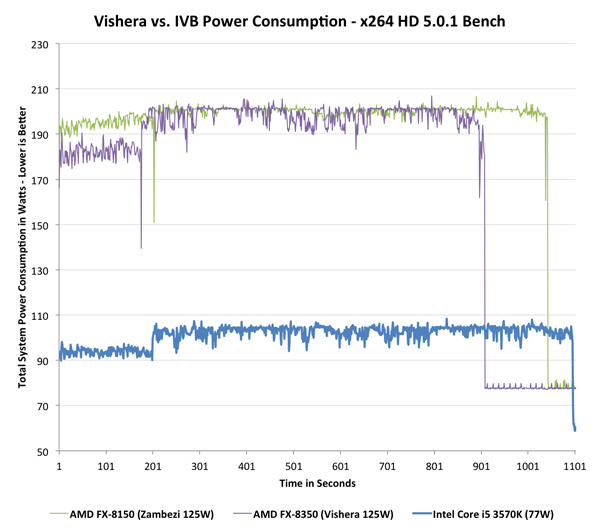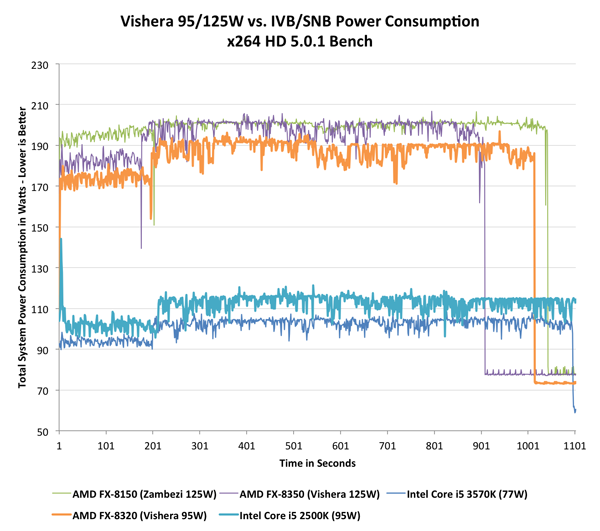The Vishera Review: AMD FX-8350, FX-8320, FX-6300 and FX-4300 Tested
by Anand Lal Shimpi on October 23, 2012 12:00 AM ESTPower Consumption
With Vishera, AMD was in a difficult position: it had to drive performance up without blowing through its 125W TDP. As the Piledriver cores were designed to do just that, Vishera benefitted. Remember that Piledriver was predominantly built to take this new architecture into mobile. I went through the details of what makes Piledriver different from its predecessor (Bulldozer) but at as far as power consumption is concerned, AMD moved to a different type of flip-flop in Piledriver that increased complexity on the design/timing end but decreased active power considerably. Basically, it made more work for AMD but resulted in a more power efficient chip without moving to a dramatically different architecture or new process node.
In mobile, AMD used these power saving gains to put Piledriver in mobile APUs, a place where Bulldozer never went. We saw this with Trinity, and surprisingly enough it managed to outperform the previous Llano generation APUs while improving battery life. On desktops however, AMD used the power savings offered by Piledriver to drive clock speeds up, thus increasing performance, without increasing power consumption. Since peak power didn't go up, overall power efficiency actually improves with Vishera over Zambezi. The chart below illustrates total system power consumption while running both passes of the x264 HD (5.0.1) benchmark to illustrate my point:
In the first pass Vishera actually draws a little less power, but once we get to the heavier second encode pass the two curves are mostly indistinguishable (Vishera still drops below Zambezi regularly). Vishera uses its extra frequency and IPC tweaks to complete the task sooner, and drive down to idle power levels, thus saving energy overall. The picture doesn't look as good though if we toss Ivy Bridge into the mix. Intel's 77W Core i5 3570K is targeted by AMD as the FX-8350's natural competitor. The 8350 is priced lower and actually outperforms the 3570K in this test, but it draws significantly more power:
The platforms aren't entirely comparable, but Intel maintains a huge power advantage over AMD. With the move to 22nm, Intel dropped power consumption over an already more power efficient Sandy Bridge CPU at 32nm. While Intel drove power consumption lower, AMD kept it constant and drove performance higher. Even if we look at the FX-8320 and toss Sandy Bridge into the mix, the situation doesn't change dramatically:
Sandy Bridge obviously consumes more than Ivy Bridge, but the gap between a Vishera and any of the two Intel platforms is significant. As I mentioned earlier however, this particular test runs quicker on Vishera however the test would have to be much longer in order to really give AMD the overall efficiency advantage.
If we look at average power over the course of the two x264 encode passes, the results back up what we've seen above:

As more client PCs move towards smaller form factors, power consumption may become just as important as the single threaded performance gap. For those building in large cases this shouldn't be a problem, but for small form factor systems you'll want to go Ivy Bridge.
Note that idle power consumption can be competitive, but will obviously vary depending on the motherboard used (the Crosshair Formula V is hardly the lowest power AM3+ board available):














250 Comments
View All Comments
ET - Tuesday, October 23, 2012 - link
I'm sorry, but I can't take seriously anything where the writer uses "Windoze". Any such text is obviously written by a heavily biased individual and therefore any "analysis" in it is flawed.Finally - Tuesday, October 23, 2012 - link
I'm sorry, but I can't take seriously anything where the writer uses the screen name "ET"...extide - Tuesday, October 23, 2012 - link
X2 this guy is one of those "Linux Zealots" Pretty sad that there are still people out there that feel that way.andrewaggb - Tuesday, October 23, 2012 - link
It would be interesting to see some linux benchmarks considering this chip's only future may be running servers or bargain machines.Some linux webserver and sql database benchmarks would be interesting. I didn't see any desktop use case for this processor at all. In every benchmarked case I'd rather have an intel chip. Even when Intel lost it wasn't by much. And the conclusion basically said the same thing, if you are 100% sure you are running heavily threaded code all the time, then this MIGHT be the chip for you if you don't mind a bigger power bill. That's just not great.
But as for the windows remark, windows is fine. Linux has some strong points, particularly with servers, and it's kernel->user mode transitions, but everything is a trade off. I use linux for many of my servers and have for years, but I mostly agree with this http://linuxfonts.narod.ru/why.linux.is.not.ready.... as to the problems with linux. If you've genuinely used linux alot, you'll know most of these things are true to one degree or another. Basically once you get X audio and video involved, it's not awesome and you'll appreciate windows more :-)
redwarrior - Thursday, October 25, 2012 - link
If you prefer to analyze things scientifically and think independently you would NOT use your computer primarily or exsclusively for gaming, you are a one-dimensional human being IIt is a multi-faceted tool that can do work , organize a revolution, spread joy through its communications ability. Help the oppressed get together to fight their expoliters It can be entertaining as well. Practicing being a paid mercenary like the Seals does not intrigue me, it repulses me.There is nothing this cpu can't do either better . as well, or almost as well asan Interl chip in its price class. Single-threaded apps are dying out. More and more games are being programmed to take advantage of multi cores and AMDs' superiority there is only going to grow. Dis it all you like it show your brain is not eoperating at a high efficiency. it is irrational just liek those Iphone nuts who stand on line for aproduct that is being bought as a status symbol rather than as a superior tool (which it is not).
CeriseCogburn - Tuesday, October 30, 2012 - link
Thank you so much mr revolution. By the way obnoxious idiot, you have NO IDEA how the person you responded to uses his or her computer(s) !We get it, you're a dyed in the wool amd freak. Now explain how the 2500K at 4500mhz on stock everything doesn't smoke the spanking lies out of you?
LOL - see you at the FEMA CAMP, i'll be on the other side of the barbed wire, mr revolutionary.
SlyNine - Saturday, November 17, 2012 - link
Let me just say. Shut up.als2we - Friday, August 16, 2013 - link
Just look at the facts , more performance for your $$ http://www.cpubenchmark.net/cpu.php?cpu=AMD+FX-835...AMD has it there we need it there , if amd goes away Intel can charge what ever they want ..........
SlyNine - Saturday, November 17, 2012 - link
It doesn't matter if something is multithreaded or not. If it doesn't use more than 4 threads Intel's Single threaded advantage still holds.Only until you fully saturate the 8threads does the AMD, maybe, pull ever so slightly ahead. Even sometimes there it falls way behind.
If the amount of threads your software is asking is equal to the amount of cores your Core I7,5,3 has the Intel is spanking AMD. Only if the amount of cores DOUBLES intel's is the AMD maybe winning alittle bit.
apache1649 - Friday, November 29, 2013 - link
I'm sorry, this is a bit off-topic to the processors (although I can't say I'm partial to either, I'll be using an AMD because it works in the motherboard I want and performs well with all the other parts I want, but I have used my friend's i5 build and it runs very nicely) but how do you say that Linux is only for servers and bargain builds? Besides the fact that I have seen $600 builds that blow away multiple thousand dollar builds, Linux has become an extremely advanced OS in the last few years. The desktop environments available are all more intuitive than either Windows or Mac, given that they can be customized to the user's preferences down to where they interact directly with the kernel. Not to mention they offer a vast array of features that Windows and Mac don't, as well as using far less resources. I have Linux operating systems that will idle around 1.2% CPU usage. Windows 7 idles around 5%-6%. It manages network connections more efficiently, utilizes the resources it does use much more effectively, and in general just gives a much more immersive and intuitive user experience if you know what you're doing. I would really like to see more support for Linux, because if software and firmware that is available for Windows was available for Linux without the use of WINE, I would use Linux exclusively because it would be so much more efficient, and at this point it has become so streamlined and beautiful that most people who have seen me using it and are Windows users say they would switch because of it's ease of use and visual appeal if only all the software they use on Windows was available. Oh and putting servers and bargain builds in the same group really wasn't well thought out... Most servers have high end components to be able to handle large amounts of traffic and heavy loads on resources.